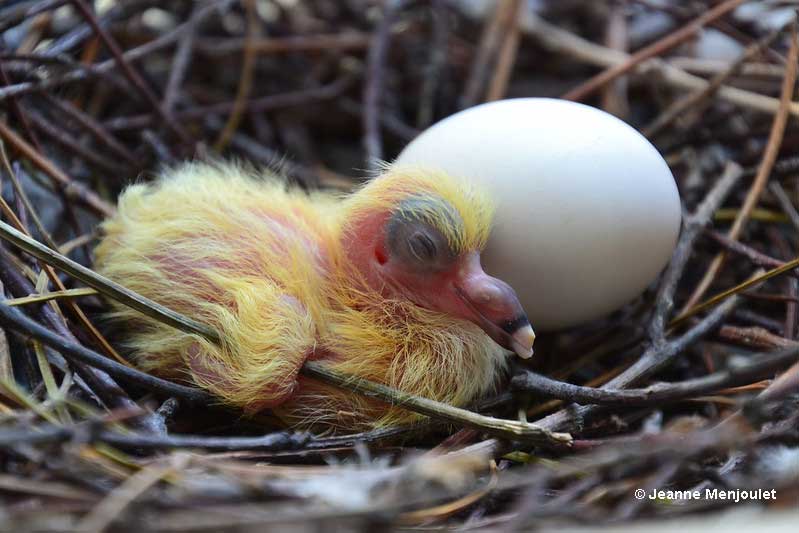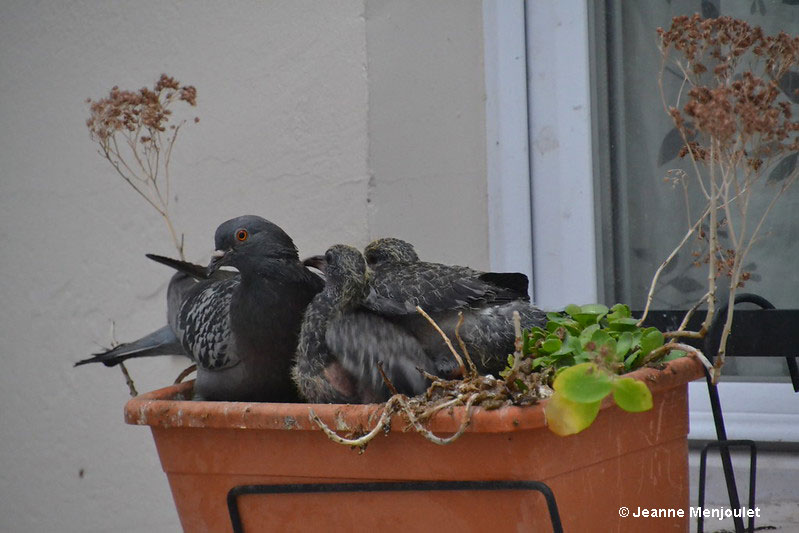
Pigeons are some of the more commonly seen birds. We find pigeons on city streets, in parks, roosting and cooing on buildings, and flocking in farm fields. But have you ever seen a baby pigeon?
Baby pigeons stay hidden from our view – they start off as tiny hatchlings who are completely helpless.
As with other birds, pigeons build plenty of nests, lay eggs, and take care of their young, but because the nestlings are so vulnerable, their parents try their best to keep them hidden.
Like many baby birds, when pigeons are born, they are helpless and completely rely on their parents. If a predator finds them, it doesn’t take much effort to catch them.
Since baby pigeons are common but rarely seen, we created this article to answer most of the questions frequently asked about these cute little birds.
On this page
Nest
The male Rock Pigeon (also known as Rock Doves) chooses a nesting site and makes cooing calls to attract a mate. The nesting site is a ledge on a building or other flat surface covered by a roof or other structure.
If an old pigeon nest is present, that is often used as a base for the new nest. Such situations approximate the cliff ledges or caves used as nest sites by Rock Pigeons in wilder places. If the male pigeon attracts a female, she sits on the nesting site and coos as he brings her small sticks or other stick-like objects.
The female pigeon places and arranges the sticks and twigs around her to make a clumsy, shallow structure and lays two white eggs that weigh 15 to 17 grams each.
Both parents incubate the eggs, with males incubating during the middle of the day, and females sitting on the eggs in the late afternoon, night, and early morning.
Read more: How long do pigeons live?
The eggs hatch after 18 days, and the young are naked except for some yellowish down feathers. During the first week of their lives, they can barely move, only opening their mouths to be fed “crop milk,” a secretion made by both parents that is high in fat and protein.
After a week, the baby pigeons are fed a diet that consists mostly of seeds, they quickly grow and attain feathers, and leave the nest around 30 days after hatching. In cold weather, baby pigeons may remain in the nest up to 45 days after hatching.
What Does A Baby Pigeon Look Like?
Newborns, or newly hatched baby pigeons look similar to other “altricial” birds. This is the term for baby birds born naked or nearly naked and helpless.
In the case of baby pigeons, they are born with their eyes closed, have some stringy, yellowish down feathers, and are around two inches in length. Their skin is gray and pink, the feet, wings, and pink bill look too big for their bodies, and they weigh around 15 grams.
After four or five days, the baby pigeons open their eyes, make begging sounds, stretch their neck to get food, and can move their wings. A week after hatching, they move towards their parents to get food and can make hissing noises and snap their bills at potential predators.
Baby pigeons grow fast and gain four to eight grams per day, but after a week, put on 20 grams of weight each day, weighing up to 350 grams by the time they leave the nest.
Related: Baby Birds – From Hatching to Adulthood
They start to grow feathers five days after hatching, are fairly well-feathered after two weeks, and have most of their feathers a month after hatching.
When baby pigeons leave the nest, they look like small adults with fewer feathers, especially around the head and neck. Fledgling pigeons stay near the nest for a week or more but fend for themselves. This is the time baby pigeons will start looking like adults when their adult plumage.
For other species of pigeons, for example, European Wood Pigeons, the process is fairly similar.
How To Tell Baby Pigeons Apart?
Although it is very hard to see a baby pigeon in the nest, hatchlings are nearly naked with yellowish down feathers and have a rather big, pinkish bill.
The fledglings or “squabs” have dark feathers and resemble adults but have much less feathering on the head and neck. When the young birds leave the nest, they can look a lot like adults but tend to be smaller.
However, they quickly grow to adult size and have plumage that resembles that of the adult except for lacking iridescent colors on the neck, having a grayish-pink base of the bill, and having dark brown eyes instead of reddish eyes.
What Do Baby Pigeons Eat?
After hatching, both parents feed juvenile pigeons a mixture of fat and protein called “crop milk.” The babies eat this important, regurgitated food four times a day for a week.
Related: What do baby birds eat?
A week after hatching, juveniles beg for food much more and are fed seeds, some fruits, and occasional invertebrates twice per day.
Frequently Asked Questions
Why do we hardly ever see baby pigeons?
We hardly ever see baby pigeons because they remain in nests, hidden from sight on ledges, in church steeples, under bridges, and in other inaccessible spots. Once they emerge from the safety of their nest, they are difficult to tell apart from adult birds.
What do pigeon eggs look like?
Pigeon eggs are white, and there are generally two of them. They are much smaller than chicken eggs. The eggs usually hatch in around 18 days.
What is a chick pigeon called?
Young pigeons have many names, but the most common name for chick pigeons is a squab. Other names include peeps, squeakers or squealers, and pipers.
How long does a pigeon stay a baby?
Baby pigeons are considered to be chicks for at least 30 days. This is roughly the same time thy stay in the nest.
Is it OK to pick up a baby pigeon?
In certain situations, it is OK to pick up a baby pigeon, but only to place it in a safer spot, such as in a tree or the nest. After placing the young bird back in the nest, make sure that the parents return.
What is the lifespan of a pigeon?
The lifespan of a wild pigeon is only around three years, but in captivity, they can live much longer. One homing pigeon lived for 30 years.
Do pigeons mate for life?
Pigeons end to mate for life, but there are instances where this might not be the case. For example, they might find another one when the pigeon’s mate dies.
Read next: What to do if you find a baby bird



